
Australian Light Horse were mounted troops with characteristics of both cavalry and mounted infantry, who served in the Second Boer War and World War I. During the inter-war years, a number of regiments were raised as part of Australia's part-time military force. These units were gradually mechanised either before or during World War II, although only a small number undertook operational service during the war. A number of Australian light horse units are still in existence today.

The First Australian Imperial Force was the main expeditionary force of the Australian Army during the First World War. It was formed as the Australian Imperial Force (AIF) following Britain's declaration of war on Germany on 15 August 1914, with an initial strength of one infantry division and one light horse brigade. The infantry division subsequently fought at Gallipoli between April and December 1915, with a newly raised second division, as well as three light horse brigades, reinforcing the committed units.

The Royal Australian Armoured Corps (RAAC) is a corps of the Australian Army which provides the Australian Defence Force's armour capability. Armour combines firepower, mobility, protection and networked situational awareness to generate shock action and overmatch in close combat. Armour is an essential element of the combined arms approach that is employed by the Australian Army.

1st Armoured Regiment is an armoured regiment of the Australian Army and is the senior regiment of the Royal Australian Armoured Corps. Formed as a tank unit in the new Australian Regular Army on 7 July 1949, the regiment subsequently saw service during the Vietnam War operating Centurion tanks. Currently the unit is based in Edinburgh, South Australia as part of the 9th Brigade. As part of the Plan Beersheba reorganisation, the unit has become one of three Armoured Cavalry Regiments (ACRs) assigned to the Army's multirole combat brigades in Brisbane, Darwin and Townsville. Each ACR is equipped with M1A1 tanks and ASLAV light armoured vehicles.
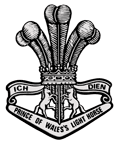
The 4th/19th Prince of Wales's Light Horse is a cavalry regiment of the Australian Army. The regiment in its current composition was formed in 1948 when the Citizens Military Force (CMF) was re-raised after the completion of the demobilisation process following the end of the Second World War and it was formed through the amalgamation of three previously existing regiments. Through these predecessor units, 4/19 PWLH can trace its lineage back to the 19th century and today it is the custodian of the battle honours earned by these units. The regiment had a Regular squadron, 1 Troop 4th/19th Prince of Wales Light Horse Regiment, which was posted to South Vietnam in 1965 where it was attached to 1 RAR operating out of Bien Hoa Province. It returned to Australia on 28 May 1966 and became part of the Regular cavalry units that continue to exist in the Australian Army today. These units subsequently served during the Vietnam War and many of their personnel continued to wear regimental accoutrements while in South Vietnam.

The 2nd/14th Light Horse Regiment is a regiment of the Australian Army and forms part of the Royal Australian Armoured Corps. The regiment is an Australian Light Horse unit, and has been widely romanticised and popularised in literature and poetry throughout the 20th Century. The unit sentimentally traces its lineage to 1860 and is the oldest Australian Regular Army unit through antecedent units the 2nd Moreton Light Horse (QMI) and the 14th West Moreton Light Horse (QMI). The regiment is assigned to 7th Brigade based in Brisbane and is equipped with the M1A1 Abrams tank and the ASLAV reconnaissance vehicle.
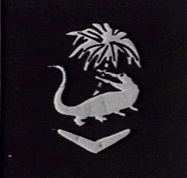
The 4th Armoured Brigade was an armoured formation of the Australian Army established during the Second World War. It was formed in February 1943 to provide armoured support for infantry units operating in the South West Pacific Area. Its composition varied over time, but usually comprised several armoured regiments equipped with Matilda II or M3 Grant tanks as well as some support units.
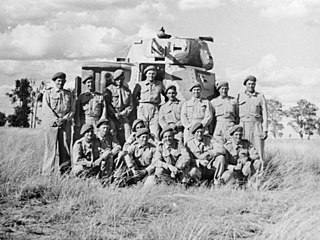
Armoured units made a relatively small, but important, contribution to Australia’s war effort during World War II. While Australia formed three armoured divisions and two independent armoured brigades during the war, Australian armoured units only saw action as independent regiments and companies supporting larger infantry formations. Early actions were fought in the Middle East by the divisional carrier regiments that supported the 6th, 7th and 9th Divisions, fighting in Libya, Egypt and Syria in 1941–42, before the Australian divisions returned to Australia in 1942–43. During the early fighting in the Pacific, there was a limited role for armoured formations, although one armoured regiment – the 2/6th – took part in the fighting around Buna–Gona in late 1942. Later in the war, though, during the Huon Peninsula, Bougainville and Borneo campaigns of 1943–45, several armoured units were used by Australian forces in the infantry support role.

Unit colour patches are a method of identification used by the Australian Army, used to indicate which unit a soldier belongs to.
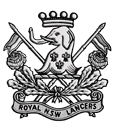
The 1st/15th Royal New South Wales Lancers is an active Australian Army Reserve Cavalry regiment. The regiment has its headquarters at Lancer Barracks in Parramatta, a suburb in Western Sydney, New South Wales. Lancer Barracks is the oldest Military Barracks on mainland Australia and dates from 1819.

The 12th/16th Hunter River Lancers is an Australian Army Reserve cavalry regiment. It was formed on 1 May 1948, although it draws its lineage from units that were originally formed in the 1880s. It is currently a Light Cavalry unit equipped with Bushmaster Protected Mobility Vehicles. The regiment forms part of the 11th Brigade, attached to the 2nd Division and draws its members from regional centres in northern New South Wales, hence the reference to the Hunter River. Since 2000 the regiment has provided individuals as reinforcements to round-out Regular Army units deploying overseas on peacekeeping operations and in the conflicts in Iraq and Afghanistan.

The 1st Light Horse Brigade was a mounted infantry brigade of the Australian Imperial Force (AIF), which served in the Middle Eastern theatre of World War I. The brigade was initially formed as a part-time militia formation in the early 1900s in New South Wales and then later in Queensland. In 1914, the brigade was re-constituted as part of the AIF and was sent to Egypt. Forming part of the New Zealand and Australian Division, during the Gallipoli Campaign it served in a dismounted role between May and December 1915. After being withdrawn to Egypt it served in the Anzac Mounted Division from March 1916 as part of the Egyptian Expeditionary Force, taking part in the Sinai and Palestine Campaign until the end of the war. It was disbanded in 1919. After the war, the AIF light horse regiments were demobilised and disbanded; however, the brigade briefly existed as a part-time militia formation in Queensland until 1921 when its regiments were reorganised into cavalry brigades.

The 2nd Light Horse Brigade was a mounted infantry brigade of the Australian Imperial Force (AIF) which served in the Middle Eastern theatre of World War I. The brigade was initially formed as a part-time militia formation in the early 1900s in New South Wales. In 1914, the brigade was re-constituted as part of the AIF. The brigade first saw action while serving in the Australian and New Zealand Army Corps (ANZAC) during the Gallipoli campaign. After being withdrawn to Egypt in February 1916 they served in the ANZAC Mounted Division from March 1916 as part of the Egyptian Expeditionary Force during the Sinai and Palestine Campaign until the end of the war. After the war, the AIF light horse regiments were demobilised and disbanded; however, the brigade briefly existed as a part-time militia formation in New South Wales until 1921 when its regiments were reorganised into cavalry brigades.

The 1st Armoured Brigade was a formation of the Australian Army during World War II. The brigade was formed in July 1941, at Greta, New South Wales from volunteers for the Second Australian Imperial Force and was assigned to the 1st Armoured Division. Raised initially for service in the Middle East, following Japan's entry into the war, the brigade was assigned to the defence of Australia in case of an invasion. After garrison duties in New South Wales and Western Australia, it was disbanded in November 1944 without seeing active service, although some of its former units saw action later with other formations.

The 3rd/9th Light Horse is a Reserve light cavalry regiment of the Australian Army based in Smithfield, South Australia. Part of the Royal Australian Armoured Corps (RAAC), the regiment is attached to the 9th Brigade, 2nd Division and currently operates G-Wagon SRV 6x6 and Bushmaster Protected Mobility Vehicles. On 26 October 2022, 9th Brigade transitioned as a Direct Command to Forces Command (FORCOMD) as part of an Army wide transformation. 3rd/9th Light Horse, 1st Armoured Regiment officially commenced on 1 November 2022.

The 10th Light Horse Regiment is a "mounted infantry" regiment of the Australian Army Reserve, raised in Western Australia (WA).

The 6th Light Horse Regiment was a mounted infantry regiment of the Australian Army during the First World War. The regiment was raised in September 1914, and assigned to the 2nd Light Horse Brigade. The regiment fought against the forces of the German Empire and the Ottoman Empire, in Egypt, at Gallipoli, on the Sinai Peninsula, and in Palestine and Jordan. After the armistice the regiment eventually returned to Australia in March 1919. For its role in the war the regiment was awarded sixteen battle honours. During the inter-war years, the regiment was re-raised as a part-time unit based in New South Wales, adopting the designation of the "New South Wales Mounted Rifles". It was later converted to a motor regiment during the early years of the Second World War before being redesignated as an armoured car regiment. Nevertheless, it was disbanded in early 1943 without having been deployed overseas. During the post war years, the regiment was re-raised as part of the Citizens Military Force, and in 1956 was converted into an infantry unit, and in 1960 was subsumed into the Royal New South Wales Regiment.
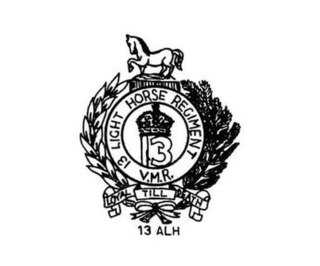
The 13th Light Horse Regiment was a mounted infantry regiment of the Australian Army during the First World War. The regiment was raised in March 1915, and eventually assigned as the mounted regiment for the Australian Corps. During the war the regiment fought against the forces of the Ottoman Empire, at Gallipoli, and against the German Empire on the Western Front. For its role in the war the regiment was awarded twelve battle honours. In 1921, it was later re-raised as a part-time unit of the Citizens Forces, and was briefly amalgamated with the 19th Light Horse. During the Second World War, the regiment was converted into an armoured regiment, designated the "13th Armoured Regiment", although it was disbanded in late 1943 without seeing action.
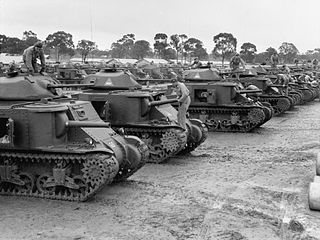
The Australian Army has used tanks from after the First World War, through the interwar period, the Second World War, the Cold War and to the present day. Throughout this period the Army has primarily been a light infantry force, with its tanks mainly being used in the direct support role. The Australian Army's tanks have seen combat during the Second World War and the Vietnam War, where they proved successful despite some of the designs employed being considered obsolete. The first Australian tanks were a small number of British medium and light tanks which were operated mainly for training purposes during the 1920s and 1930s.

The New South Wales Lancers Memorial Museum is a military museum at Linden House, 2 Smith Street, Parramatta, Sydney, Australia. The museum's collection is heritage-listed, having been added to the New South Wales State Heritage Register on 14 May 2010.






















